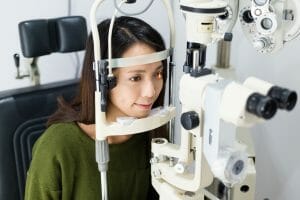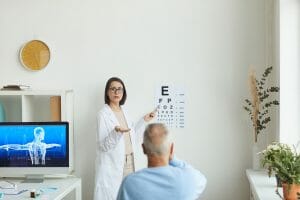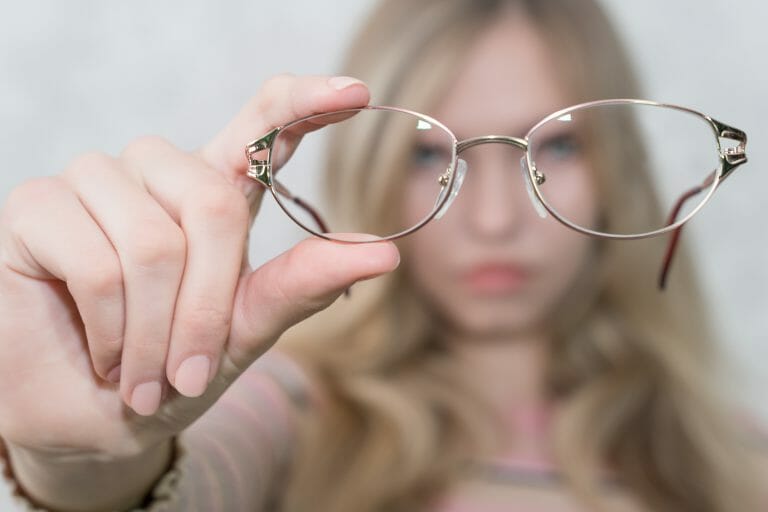If you find it hard to see far-distance objects such as highway signs, road signs, advertisement board texts, etc. but can easily read books up close, most likely you are suffering from myopia or nearsightedness. American Academy of Ophthalmology also defines myopia as refractive errors in the eyes. Nearsightedness may develop rapidly or gradually, usually worsening during childhood ages and young ages. This condition is pretty common among all of us and quite significantly affects our eye health. Most myopic people are under age 40, and the defect’s ratio is continuously increasing at an alarming rate in the past few years. Research showed that roughly 25% of the world’s population was nearsighted. The percentage will increase to more than 50% by 2050. Imagine, every second person you know has a poor vision.
Myopia Symptoms
Myopia symptoms include eye fatigue when you see distant objects or things placed far away, squinting, eye strain, visual stress, and headaches. Myopia may make you feel everything blurry around you. If you feel fatigued when playing sports or driving cars, you are probably suffering from this defect. Distant objects are blurred for myopic people. If you observe these signs and symptoms while wearing glasses or contacts, you should get an appointment with your eye doctor for an eye exam to see if you need a much more strong prescription.
Myopia Diagnosis
A basic eye exam is conducted to diagnose myopia. The exam includes a refraction assessment and a proper eye health exam. You may come to know that you need to wear glasses to improve your vision.

A refraction assessment can easily determine if a person has any vision defects, including presbyopia, nearsightedness, astigmatism, or farsightedness. The doctor will use numerous instruments and tell you to see through different contacts to examine your close-up and distance vision.
You may visit Mayo clinic to get yourself diagnosed. At mayo clinic, professional eye doctors can help you with the diagnosis and treatment of myopia. They may give you medical advice to wear glasses. These glasses help you to improve your vision.
Your eye doctor will most probably put drops in the eyes to dilate the pupils for your eye health exam. It may make the eyes much more light-sensitive for some time after the exam is completed. Dilation lets your doctor see wider views inside of the eyes.
Myopia Causes
Myopia occurs due to the structure of your eye. The cornea is the protective outer layer of the eyes. When your cornea is too curved, or the eyeball is too long, the light rays that enter your eyes are not forced perfectly. Instead of focusing directly on the retina (the light-sensitive part of our eyes), the image is focused in front of the retina. So basically, the eyes focus light rays in front of the retina instead of onto it. Due to this wrong image formation, blurred vision occurs. Eye doctor call this a refractive error. Refractive errors are created because the light is not focused directly on the retina. And these refractive errors cause myopia.
Myopia normally starts at the early ages of your life. If your parents are myopic, you have a higher risk of developing myopia nearsightedness. In many cases, myopia stabilizes in the early ages of adulthood, but on some occasions, it keeps on progressing with age.
Types of Nearsightedness (Myopia)
High Myopia
This form of the condition is much more serious, in which your eyeball grows more than normal and becomes quite long front to back. Other than making it challenging to see distant objects, it may also increase the chances of developing other eye conditions or eye diseases such as glaucoma, retinal detachment, or cataract. Cataract treatment includes cataract surgery. High myopia is a serious visual defect and should be treated as soon as possible.
Degenerative Myopia
Degenerative myopia is also known as malignant or pathological myopia. It is a very rare kind sufferers normally inherit from their parents. Their eyeball gets much longer in no time and causes extreme myopia, typically by the teenage or early adulthood. This kind of myopia can get even worse far into adult years. Other than making it tricky for them to view far distant objects, they can also have a greater chance of having glaucoma, detached retina, and abnormal blood vessel growth in their eyes.
Visit your Eye Doctor

If you are finding it challenging to hold your books, smartphone far away to better view social media posts or seeing objects at a closed distance, you should schedule an eye exam with your eye doctor. Myopia is treatable and, in most cases, slowed in kids.
Nearsightedness (Myopia) Treatment
There are some good and effective myopia treatments for kids who have myopia. These methods include Ortho-k contact lenses, atropine eye drops, myopia control contact lenses, and myopia control glasses. Nearsightedness may develop quickly or slowly, normally worsening during early childhood ages and adult ages.
For grownups, myopia is corrected with standard prescription refractive surgery, eyeglasses, and corrective lenses.
On the basis of your nearsightedness, you may require to wear contact lenses or glasses 24/7 or only at times when you require clear, crisp distance vision such as watching movies, driving a car, or viewing a chalkboard.
For correcting nearsightedness, you can choose eyeglass contact lenses such as contacts with anti-reflective coating and high-index contacts (for lighter, thinner glasses). Plus, go for photochromic contacts to save your eyes from UV rays and high-energy blue light, which are harmful to your eye health. These contacts reduce the requirement for a separate pair of prescription sunglasses.
If you’re myopic, the first number (“sphere”) on your eye lens prescription or eyeglasses prescription will be preceded by a minus sign (-). The more the number, the more nearsightedness is.
The requirement of a contact lens or glasses is eliminated completely or at least reduced with refractive surgery. Mostly, an excimer laser is used to perform most of the procedures.
PRK Laser
In PRK laser, the laser eliminates the corneal tissue layer, which flattens your cornea and enables light to focus more precisely and accurately on your retina.
LASIK
It is the most common refractive procedure. In this surgery, a thin flap is made on the cornea surface, a laser eliminates some of the corneal tissues, and then the flap comes back to its original position.
There is also a non-surgical treatment in which you wear special rigid gas permeable eye lenses at night that helps to reshape the cornea while you are sleeping. This procedure is known as orthokeratology.
When you remove your contacts after waking up, your cornea is temporarily able to maintain the new shape, which enables you to see clearly during the whole day without wearing glasses or eye lenses.
Corneal refractive therapy (CRT) is the combination of Orthokeratology and a related GP eye lens procedure. It is effective at correcting mild to moderate amounts of nearsightedness for a short time. If you are not good candidates or too young for LASIK for refractive surgery, you can opt for both of these procedures as fine alternatives to surgery.
Another surgical option for correcting myopia is the phatik IOLs, which are implantable lenses. This option is most suitable for people with thinner than normal corneas or high amounts of nearsightedness that can raise the risk of complications from laser vision correction procedures such as LASIK.
Phatic IOLs are just like contact lenses and work exactly like them, but they don’t need any maintenance as they are surgically implanted in your eyes and are permanent. Opposite to IOLs used in cataract surgery, phatic IOLs don’t replace your eye’s natural lenses, which are left intact.
Controlling Myopia
As more and more people are becoming myopic, there is great interest in searching for ways to control the progression of this visual defect in childhood.
A lot of various techniques have been tried, such as fitting kids with gas permeable eye lenses, bifocals, and progressive contacts. All of them have given mixed outcomes.
After some recent clinical trials, it is seen that low-dose atropine eye drops may slow down the myopia progression in small kids, with quite significantly fewer side effects in comparison to higher concentration eye drops. There were also some kids who didn’t respond to atropine drops as expected.
According to research shown at the American Optometric Association meeting in 2017, it was observed that the progression rate of nearsightedness in kids between 8 and 12 years old is decreased with a dual-focus daily disposable eye lens as compared to a single vision eye lens.
A multifocal daily disposable contact lens decreased the progression rate of myopia in children between eight and twelve years old when compared to a single vision lens, according to a study presented in 2017 at the American Optometric Association meeting.
These specially designed dual-focus lenses decrease nearsightedness progression by almost 59% at one year, 54% at two years, and 52% at three years, compared with the nearsightedness progression experienced by kids who wore typical eye lenses. Due to these lenses, there are good correlations between change in eyeball growth and refractive error.
Does Nearsightedness Get Better Over Time?
Nearsightedness most probably starts in childhood and runs in families for ages. Dual-Focus glasses or contacts and eye drops like cyclopentolate, atropine, or pirenzepine gel helps in slowing down its progression. The eyes are typically stopped from changing after teenage, but not every time. The nearsightedness incidents are increasing day by day at a dangerous rate in the past few years. If you observe changes in your vision, you need to get them checked by a doctor so that you are able to see objects clearly. If you won’t do that, it can get worse with the passing time.


